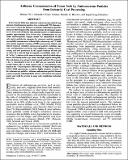Por favor, use este identificador para citar o enlazar a este item:
http://hdl.handle.net/10261/81854COMPARTIR / EXPORTAR:
 SHARE SHARE
 CORE
BASE CORE
BASE
|
|
| Visualizar otros formatos: MARC | Dublin Core | RDF | ORE | MODS | METS | DIDL | DATACITE | |

| Título: | Airborne contamination of forest soils by carbonaceous particles from industrial coal processing |
Autor: | Schmidt, M. W. I.; Knicker, Heike CSIC ORCID ; Hatcher, Patrick G.; Kögel-Knabner, I. | Fecha de publicación: | 2000 | Editor: | Crop Science Society of America | Citación: | Journal of Environmental Quality 29 (3): 768-777 (2000) | Resumen: | In the German Ruhr-area industrial coal processing emitted large amounts of carbonaceous particles for a century until 1970. Our objectives were to detect the presence of airborne carbonaceous particles and assess their impact on the chemical structure of soil organic matter in two forest soils (Podzols) with potential sources of carbonaceous particles approximately 10 to 30 km away. Contamination was not visible macroscopicaily. Organic matter was characterized in bulk soils and in particle-size separates by elemental analysis, magnetic susceptibility measurement, reflected light microscopy, and 13C solid-state nuclear magnetic resonance (NMR) spectroscopy. Organic and mineral horizons contained carbonaceous particles including char, coke, and bituminous coal from coal combustion, coking, coal processing, and steel production. In the organic horizons of both soils we observed a material high in magnetic susceptibility (max. 109 × 10−8 m3 kg−1), whereas in the mineral horizons only the Podzol with an intense intermixing moder-type humus had high magnetic susceptibly. This Aeh horizon was extremely rich in organic carbon (139.4 g organic C kg−1), concentrated in the 20 to 2000 µm size separates. In the second Podzol, like in many natural soils, C concentrations were largest in the <20 µm separates. Bloch decay 13C magic angle spinning (MAS) NMR spectroscopy revealed a highly aromatic structure of the carbonaceous particles. Airborne carbonaceous particles formed a macroscopically indistinguishable mixture with natural soil organic matter and could be present in many soils neighboring industrialized areas. | Versión del editor: | http://dx.doi.org/10.2134/jeq2000.00472425002900030012x | URI: | http://hdl.handle.net/10261/81854 | DOI: | 10.2134/jeq2000.00472425002900030012x | ISSN: | 0047-2425 | E-ISSN: | 1537-2537 |
| Aparece en las colecciones: | (IRNAS) Artículos |
Ficheros en este ítem:
| Fichero | Descripción | Tamaño | Formato | |
|---|---|---|---|---|
| Airbone contamination.pdf | 853,9 kB | Adobe PDF |  Visualizar/Abrir |
CORE Recommender
SCOPUSTM
Citations
24
checked on 12-abr-2024
WEB OF SCIENCETM
Citations
24
checked on 29-feb-2024
Page view(s)
377
checked on 18-abr-2024
Download(s)
327
checked on 18-abr-2024
Google ScholarTM
Check
Altmetric
Altmetric
NOTA: Los ítems de Digital.CSIC están protegidos por copyright, con todos los derechos reservados, a menos que se indique lo contrario.
